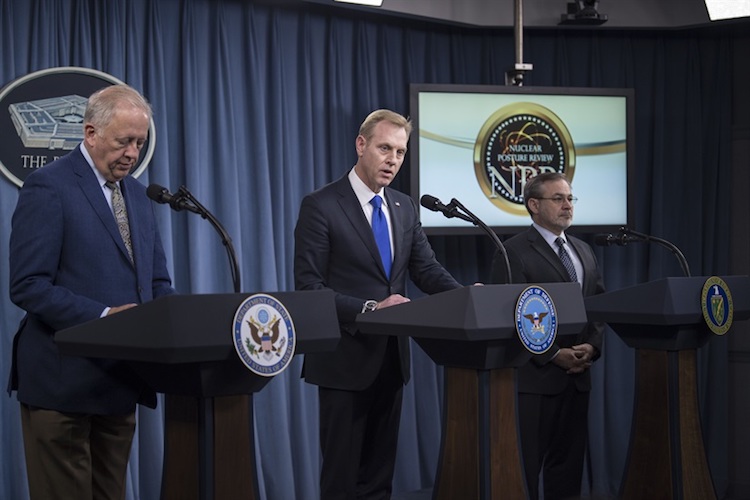By Shanta Roy
UNITED NATIONS (IDN) – The 2018 Nuclear Posture Review (NPR), released February 2, is a dangerous departure from the past, and appears to reflect a firm U.S. commitment to readily use the world’s deadliest weapons of mass destruction – even if the United States is only a target of “significant non-nuclear strategic attacks”, including cyberattacks.
The new policy statement – reflecting a wide justification for a nuclear war – should also be viewed against the continued contradictory statements made by President Donald Trump on issues such as climate change, the Iranian nuclear deal, and most importantly, the use of nuclear weapons. ITALIAN | NORWEGIAN | PERSIAN | SPANISH | JAPANESE
And, at the State of the Union address on January 30, a platform for major American policy declarations, he pointedly said: Perhaps someday in the future, there will be “a magical moment” when the countries of the world will get together to eliminate their nuclear weapons.
Unfortunately, he said, “we are not there yet, sadly.”
But that magical moment seems to be elusive – and at most, a political fantasy, particularly under a Trump administration.
Jayantha Dhanapala, a former UN Under-Secretary-General for Disarmament Affairs, told IDN that most commentaries on the Obama Administration’s Nuclear Posture Review, as spelled out in previous years, bemoaned the fact that, for a visionary leader who promised a nuclear weapons-free world, it did not go far enough to disavow any possible use of nuclear weapons.
“Trump’s policy document goes further – by promising to build new weapons and actually use them. No wonder then that the Doomsday Clock was set at two minutes to midnight or Armageddon,” he noted.
“A sharp rise in the US military budget is predictable with other nuclear weapon states responding in equal measure,” warned Dhanapala, a former President of Pugwash (2007-17).
Justifying Trump’s nuclear belligerence, the U.S. Ambassador to the United Nations Nikki Haley said the NPR makes sure “the United States remains flexible and well prepared for the unique threats we face today”.
“We want to see a world that is free of nuclear weapons, but our nuclear policy needs to be rooted in the reality of the world we live in, where aggressive regimes like North Korea threaten us and our allies with their pursuit of illegal nuclear and ballistic weapons,” she noted.
In an editorial titled ‘Playing with Fire and Fury on North Korea,’ the New York Times wrote on February 2 that “signs increasingly point to unilateral American military action” against North Korea.
“To which we say: Don’t,” the Times warned, pointing out that Trump seems to be building a case for war on “emotional grounds,” invoking the case of an American student, Otto Warmbier, who died last year after being detained in North Korea.
Besides the ominous threat to retaliate against perceived enemies with nuclear weapons, the latest NPR underlines several frightening scenarios, including a major upgrading of the U.S. nuclear arsenal; the development of two new sea-based nuclear weapons; a proposal to develop at least 12 new Columbia class submarines to be operational in 2031; and the development and deployment of 100 new land-based missiles to replace the Minute-man missile force.
The sea-based weapons will include a low-yield submarine-launched ballistic missile and a sea-launched cruise missile.
According to the Congressional Budget Office, the new American nuclear programs could cost as much as $1.2 trillion.
John Burroughs, executive director of the New York-based Lawyers Committee on Nuclear Policy, said the NPR ignores international legal obligations of the United States and increases the risks of nuclear war.
The Trump NPR, he said, asserts in passing that the “conduct of nuclear operations would adhere to the law of armed conflict.”
Thus a 2013 Report on Nuclear Employment Strategy stated that all plans for use of nuclear weapons must “for instance, apply the principles of distinction and proportionality and seek to minimize the collateral damage to civilian populations and civilian objects.”
In public appearances last fall, Burroughs said, the present and former commanders of Strategic Command stated that orders to use nuclear weapons in violation of the law of armed conflict would be refused.
“The truth is that nuclear weapons cannot be used in compliance with that law, above all because their massive indiscriminate effects make it impossible to distinguish between military targets and civilian populations and infrastructure,” he noted.
Moreover, said Burroughs, the NPR expands the role of nuclear weapons by identifying new circumstances in which they could be used, namely in response to “strategic non-nuclear attacks” including cyberattacks.
“This change runs directly counter to an NPT commitment to reduce the role of nuclear weapons in security policies in order to facilitate disarmament. It is contrary to the requirement of good faith in pursuing disarmament. And it raises the risks of nuclear war.”
For example, he pointed out, hard-to-attribute apparent cyberattacks will be considered a possible reason to resort to nuclear weapons, a change that will be all the more risky if other nuclear powers emulate the U.S. policy.
Rick Wayman, Director of Programs at the Nuclear Age Peace Foundation, stated: “The review does not contain a single reference to Article VI of the UN Treaty on the Non-Proliferation of Nuclear Weapons, which obligates the U.S. and the other nuclear-armed nations signatories to the treaty to negotiate in good faith for nuclear disarmament.”
This posture review signals such a radical and dangerous shift in U.S. nuclear policy direction NATO states will be forced to re-evaluate their positions to not automatically accept and support the U.S. in this changed nuclear policy, he added.
According to the Federation of American Scientists, Russia has about 4,300 nuclear warheads compared with 4,000 with the U.S., 300 with France, 270 with China and 215 with UK – all five permanent members of the UN Security Council.
Trailing behind them are the world’s other four nuclear powers: Pakistan (140 nuclear warheads), India (130), Israel (80) and North Korea (15).
Kingston Reif, director for disarmament and threat reduction with the Arms Control Association, said the new NPR breaks with past U.S. policy and “aligns with President Trump’s more aggressive and impulsive nuclear notions.”
Joan Rohlfing, president of the Nuclear Threat Initiative, said the NPR makes no mention of a U.S. vision of a world without nuclear weapons, as Washington has previously stated for decades.
“The overall takeaway from this NPR is that we need more weapons and more roles for our nuclear weapons in our national security… [which] really undermines our nonproliferation objectives and it makes us less safe over time,” she warned.
David Krieger, President of the Nuclear Age Peace Foundation said: “The prohibition and elimination of nuclear weapons is the only rational choice. World leaders must now take the right step and sign the Treaty on the Prohibition of Nuclear Weapons that opened for signatures at the United Nations on September 20, 2017.”
By doing so, he added, they would lead the world away from almost certain annihilation and toward the worthy goal of eliminating nuclear weapons and creating a safer and more secure world for all of humanity. [IDN-InDepthNews – 06 February 2018]
Photo: Deputy Defense Secretary Patrick M. Shanahan, center, Undersecretary of State for Political Affairs Thomas A. Shannon Jr., left, and Deputy Energy Secretary Dan Brouillette brief the press on the 2018 Nuclear Posture Review at the Pentagon, Feb. 2, 2018. DoD photo by Navy Petty Officer 1st Class Kathryn E. Holm




